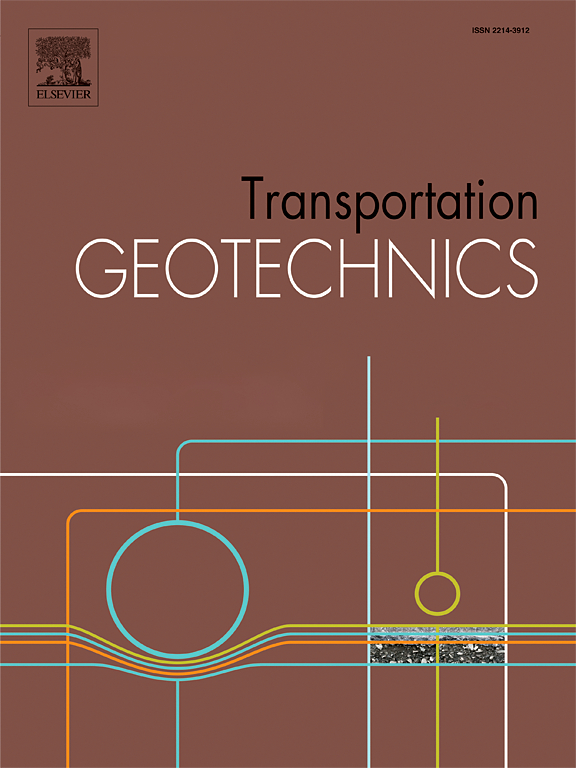Utilising construction and demolition waste in soft soil stabilisation: A prediction model for enhanced strength and stiffness
IF 4.9
2区 工程技术
Q1 ENGINEERING, CIVIL
引用次数: 0
Abstract
Utilising recycled materials, such as construction and demolition waste (C&DW), into soil improvement projects offers a promising solution to reduce the environmental impact of the C&DW industry. This approach helps address issues related to waste generation, resource depletion, and environmental degradation, while enhancing the overall sustainability and resilience of soil stabilisation efforts. This study investigates the effectiveness of incorporating recycled C&DW into cement-treated peat and clayey soils to enhance their strength and stiffness. To achieve this goal, laboratory experiments were conducted on over 296 soil specimens to assess their Unconfined Compressive Strength (UCS), small-strain Young’s modulus (E0) and shear modulus (G0). These tests included varying curing times (28, 60, 90, and 120 days), different cement and recycled material content, and water-to-cement ratios. Moreover, laboratory testing methods for determining geotechnical parameters are often time-consuming and prone to challenges. In this context, reliable predictive models, such as artificial neural networks (ANNs), offer an efficient alternative for accurately assessing these parameters.
The findings of this research reveal that, along with cement content, the water-to-cement ratio (w/c) and curing time are key factors influencing the strength and stiffness of treated soft soils, underscoring their critical role in soil stabilisation. Additionally, while minimizing cement content and increasing RM yield improvements in both peat and clay, the effect is more pronounced in peat due to the time-dependent nature of pozzolanic reactions. This suggests that achieving optimal performance with increased strength and stiffness requires a carefully balanced RM content. Finally, the study demonstrates that ANN-based models can accurately predict the strength and mechanical properties of soft soils, offering a viable alternative to traditional UCS and FFR tests.
在软土稳定中利用建筑和拆除垃圾:增强强度和刚度的预测模型
利用回收材料,如建筑和拆除废物(C&;DW),进行土壤改良项目,为减少建筑和拆除行业对环境的影响提供了一个有希望的解决方案。这种方法有助于解决与废物产生、资源枯竭和环境退化有关的问题,同时增强土壤稳定工作的整体可持续性和复原力。本研究探讨了在水泥处理过的泥炭土和粘土中掺入再生碳水化合物以提高其强度和刚度的有效性。为了实现这一目标,我们对超过296个土样进行了室内试验,评估了它们的无侧限抗压强度(UCS)、小应变杨氏模量(E0)和剪切模量(G0)。这些测试包括不同的养护时间(28、60、90和120天)、不同的水泥和再生材料含量以及水灰比。此外,用于确定岩土参数的实验室测试方法通常耗时且容易遇到挑战。在这种情况下,可靠的预测模型,如人工神经网络(ann),为准确评估这些参数提供了有效的替代方案。本研究结果表明,水灰比(w/c)和养护时间与水泥含量一起是影响处理后软土强度和刚度的关键因素,强调了它们在土壤稳定中的关键作用。此外,虽然在泥炭和粘土中减少水泥含量并提高RM产量,但由于火山灰反应的时间依赖性,这种效果在泥炭中更为明显。这表明,通过增加强度和刚度来实现最佳性能需要仔细平衡RM内容。最后,研究表明,基于人工神经网络的模型可以准确预测软土的强度和力学特性,为传统的UCS和FFR试验提供了一种可行的替代方案。
本文章由计算机程序翻译,如有差异,请以英文原文为准。
求助全文
约1分钟内获得全文
求助全文
来源期刊

Transportation Geotechnics
Social Sciences-Transportation
CiteScore
8.10
自引率
11.30%
发文量
194
审稿时长
51 days
期刊介绍:
Transportation Geotechnics is a journal dedicated to publishing high-quality, theoretical, and applied papers that cover all facets of geotechnics for transportation infrastructure such as roads, highways, railways, underground railways, airfields, and waterways. The journal places a special emphasis on case studies that present original work relevant to the sustainable construction of transportation infrastructure. The scope of topics it addresses includes the geotechnical properties of geomaterials for sustainable and rational design and construction, the behavior of compacted and stabilized geomaterials, the use of geosynthetics and reinforcement in constructed layers and interlayers, ground improvement and slope stability for transportation infrastructures, compaction technology and management, maintenance technology, the impact of climate, embankments for highways and high-speed trains, transition zones, dredging, underwater geotechnics for infrastructure purposes, and the modeling of multi-layered structures and supporting ground under dynamic and repeated loads.
 求助内容:
求助内容: 应助结果提醒方式:
应助结果提醒方式:


